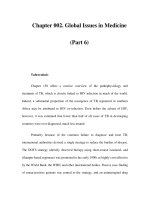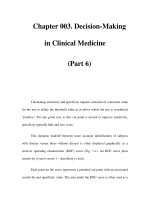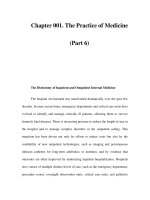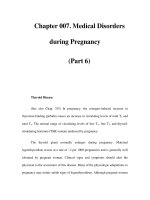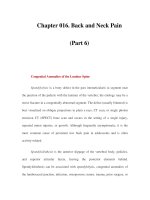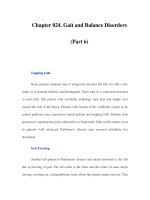Chapter 126. Infections in Transplant Recipients (Part 6) ppsx
Bạn đang xem bản rút gọn của tài liệu. Xem và tải ngay bản đầy đủ của tài liệu tại đây (14.32 KB, 5 trang )
Chapter 126. Infections in
Transplant Recipients
(Part 6)
PCR can be used to monitor EBV production after hematopoietic stem cell
transplantation. High or increasing viral loads predict an enhanced likelihood of
developing EBV-LPD and should prompt rapid reduction of immunosuppression
and search for a focus of disease. If reduction of immunosuppression does not
have the desired effect, administration of a monoclonal antibody to CD20
(rituximab or others) for the treatment of B cell lymphomas that express this
surface protein has elicited dramatic responses and currently constitutes first-line
therapy for CD20-positive EBV-LPD. However, long-term suppression of new
antibody responses accompanies therapy, and recurrences are not infrequent.
Additional B cell–directed antibodies, including anti-CD22, are under study. The
role of antivirals is uncertain because no available agents have been documented
to have activity against the different forms of latent EBV infection. Preventing
lytic replication in these patients would theoretically produce a statistical decrease
in the frequency of latent disease by decreasing the number of virions available to
cause additional infection. In case reports and small animal studies, ganciclovir
and/or high-dose zidovudine together with other agents has been used to eradicate
EBV-LPD and CNS lymphomas, another EBV-associated complication of
transplantation. Both interferon and retinoic acid have been employed in the
treatment of EBV-LPD, as has IVIg, but no large prospective studies have
assessed the efficacy of any of these agents. Several additional drugs are
undergoing preclinical evaluation. Standard chemotherapeutic regimens have been
used as a last resort, even though patients' tolerance and long-term results have
been disappointing. EBV-specific T cells generated from the donor have been used
experimentally to prevent and to treat EBV-LPD in allogeneic recipients, and
efforts are under way to increase the activity and specificity of ex vivo–generated
T cells. For further discussion, see Chap. 174.
Human Herpesvirus 8
The EBV-related gammaherpesvirus KSHV, which is causally associated
with Kaposi's sarcoma, with primary effusion lymphoma, and with multicentric
Castleman's disease, has rarely resulted in disease in HSCT recipients, although
some cases of virus-associated marrow aplasia have been reported in the
peritransplantation period. The relatively low seroprevalence of KSHV in the
population and the limited duration of profound T cell suppression after
hematopoietic stem cell transplantation provide a probable explanation for the
currently low incidence of KSHV disease. For further discussion, see Chap. 175.
Other (Nonherpes) Viruses
The diagnosis of pneumonia in HSCT recipients poses some special
problems. Because patients have undergone treatment with multiple
chemotherapeutic agents and sometimes irradiation, their differential diagnosis
should include—in addition to bacterial and fungal pneumonia—CMV
pneumonitis, pneumonia of other viral etiologies, parasitic pneumonia, diffuse
alveolar hemorrhage, and chemical- or radiation-associated pneumonitis. Since
fungi and viruses [e.g., influenza A and B viruses, respiratory syncytial virus
(RSV), parainfluenza virus (types 1, 2, and 3), metapneumoviruses, and
adenoviruses] are also causes of pneumonia in this setting, it is important to
diagnose CMV specifically (see "Cytomegalovirus," above). M. tuberculosis has
been an uncommon cause of pneumonia among HSCT recipients in Western
countries (accounting for <0.1–0.2% of cases) but is common in Hong Kong
(5.5%) and in countries where the prevalence of tuberculosis is high. The
recipient's exposure history is clearly critical in an assessment of
posttransplantation infections.
Both RSV and parainfluenza viruses, particularly type 3, can cause severe
or even fatal pneumonia in HSCT recipients. Infections with both of these agents
sometimes occur as disastrous nosocomial epidemics. Preemptive treatment of
upper airway infection and therapy for established lower tract invasion with
aerosolized ribavirin and/or the anti-RSV monoclonal antibody palivizumab have
been reported to lessen the severity of RSV disease in some studies. (Respigam, a
polyclonal anti-RSV preparation, is no longer available.) However, no large
prospective studies establishing the efficacy of these agents in HSCT recipients
have been performed. Aerosolized ribavirin is difficult to administer. Antibody in
particular may prove more active in immunocompromised hosts, but relevant
evaluation is lacking.
Influenza also occurs in HSCT recipients and generally mirrors the
presence of infection in the community. Progression to pneumonia is more
common when infection occurs early after transplantation and when the recipient
is lymphopenic. Several drugs are available for the treatment of influenza.
Amantadine and rimantadine have limited effects, primarily reducing symptoms
and shortening the duration of illness caused by sensitive strains of influenza A
virus. The neuraminidase inhibitors oseltamivir (oral) and zanamivir (aerosolized)
are active against both influenza A virus and influenza B virus and are a
reasonable treatment option. Parenteral forms of neuraminidase inhibitors are
undergoing clinical trials. An important preventive measure is immunization of
household members, hospital staff members, and other frequent contacts.
Human metapneumovirus, a paramyxovirus, can sometimes cause severe
pneumonia and respiratory failure in HSCT recipients; however, mild or even
asymptomatic infection may be more common. At present, the overall contribution
of human metapneumovirus to the burden of lower respiratory tract disease in
HSCT recipients is unknown.

